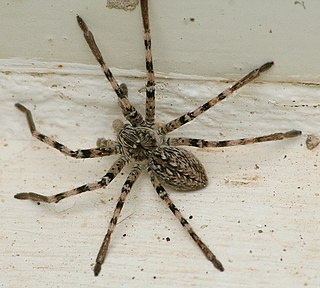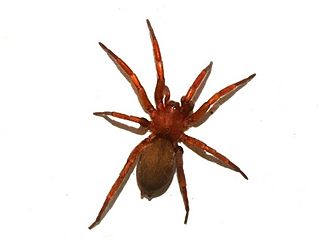
Zodarion is a genus of ant-eating spiders from the family Zodariidae. 169 species from Eurasia, North Africa and North America have been described as of November 2022.

Aelurillus is a genus of spiders in the family Salticidae.

Euophrys is a genus of jumping spiders that was first described by Carl Ludwig Koch in 1834. The small black E. omnisuperstes lives on Mount Everest at elevations up to 6,700 meters, possibly making it the most elevated animal in the world.
Ozyptila is a genus of crab spiders that was first described by Eugène Louis Simon in 1864. It has been misspelled as "Oxyptila" in multiple accounts.

Enoplognatha is a genus of comb-footed spiders that was first described by P. Pavesi in 1880. They have both a large colulus and a subspherical abdomen. Males usually have enlarged chelicerae. It is considered a senior synonym of Symopagia.

Harpactea is a genus of woodlouse hunting spiders that was first described by W. S. Bristowe in 1939. They are non-web building predators that forage on the ground and on tree trunks at night, mainly in xerothermic forests. During the day, they hide in silk retreats they build under rocks or bark.

Eusparassus is a genus of huntsman spiders, known as the stone huntsman spiders, it was first described by Eugène Louis Simon in 1903.

Lepthyphantes is a genus of dwarf spiders that was first described by Anton Menge in 1866.
Acartauchenius is a genus of dwarf spiders that was first described by Eugène Louis Simon in 1884.

Micaria is a genus of ground spiders that was first described by Niklas Westring in 1851. They are 1.3 to 6.5 millimetres long.

Haplodrassus is a genus of ground spiders that was first described by R. V. Chamberlin in 1922. They range from 3 to 10 millimetres. H. signifer is the most widespread species, found across North America except for Alaska and northern Canada.
Setaphis is a genus of ground spiders that was first described by Eugène Simon in 1893.
Pulchellodromus is a genus of running crab spiders that was first separated from Philodromus by J. Wunderlich in 2012.

Centromerus is a genus of dwarf spiders that was first described by David B. Hirst in 1886.

Palliduphantes is a genus of dwarf spiders that was first described by Michael I. Saaristo & A. V. Tanasevitch in 2001.

Pelecopsis is a genus of dwarf spiders that was first described by Eugène Louis Simon in 1864.
Typhochrestus is a genus of sheet weavers that was first described by Eugène Louis Simon in 1884.












